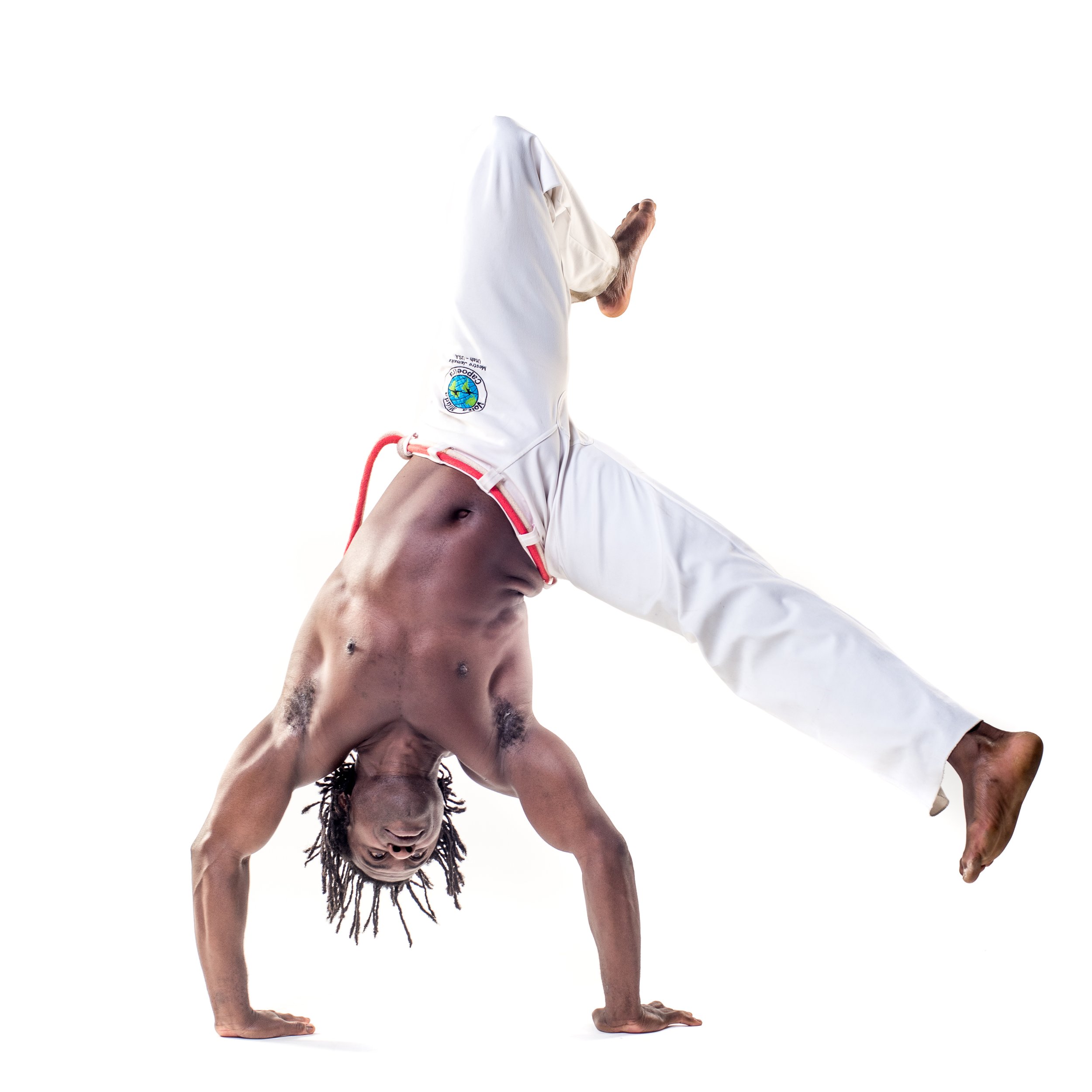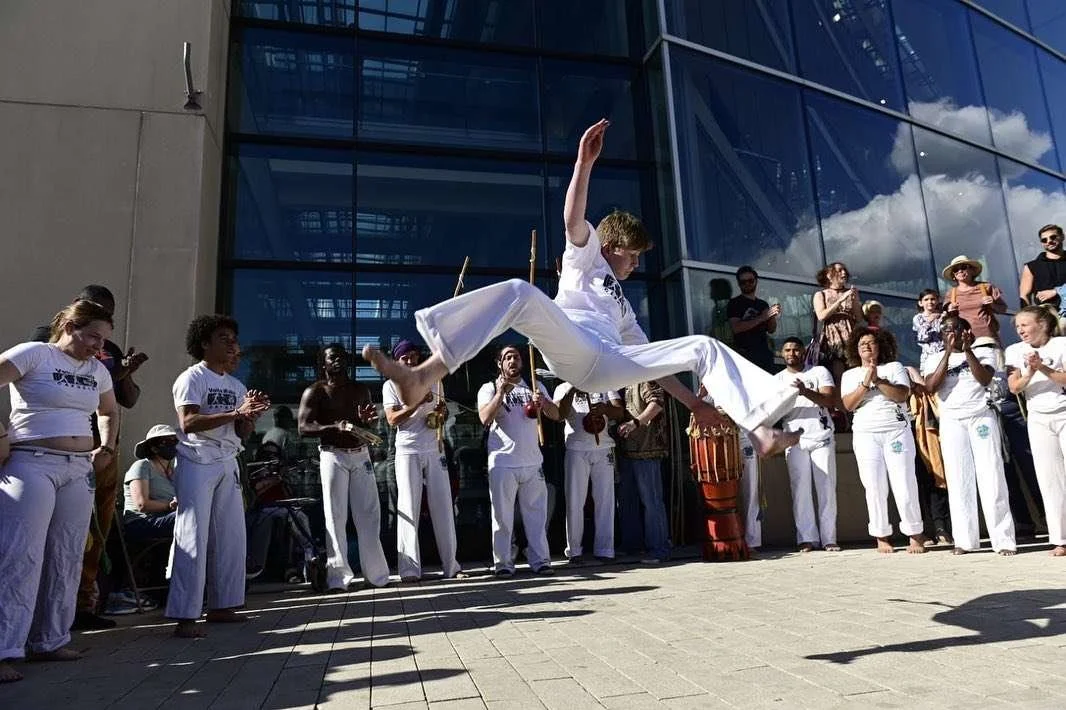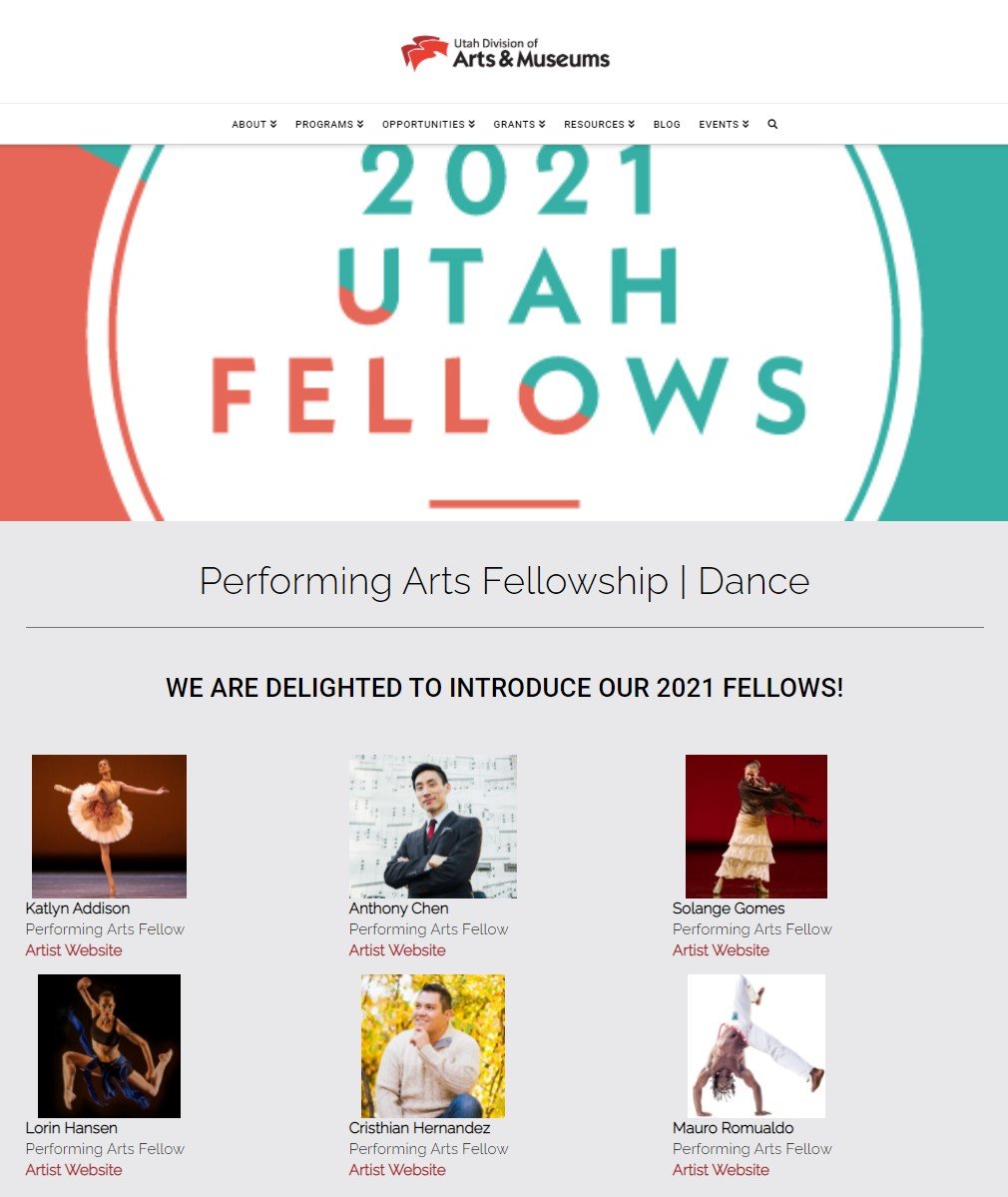We were featured on ABC4 News Utah as we highlighted our Afro-Arts Celebration. We showcased capoeira as well as Abi Goddey of 365 Poetry and Erick Fungo who shared his Tanzanian arts. See the feature on their website here.
SALT LAKE CITY — Mauro Romualdo's students — who are more like a chosen family — call him by his capoeira name, Mestre Jamaika.
"Mestre," which is Portuguese for teacher, is a title of respect used for capoeira masters. It's an apt title for Romualdo not only because of his 37 years practicing capoeira but also because of the respect and love he garners from those he's lifted up through capoeira.
"I've always had capoeira in my blood. It was just a matter of time to get to see it and activate it," he said. "Capoeira was started 100% in Brazil by my ancestors when they were forced to come to the country and become slaves. They created capoeira as a self defense disguised as a dance."
Romualdo credits capoeira — which is a combination of dance, martial arts and acrobatic movements — for transforming himself into the man he is today. As a young boy growing up in Bahia, Brazil, he felt that people looked through him instead of really seeing him.
"I remember being a young kid in Brazil and — today I know what it is — but back then I was confused and I was like why do I feel like I'm being excluded? No matter what I did, people always saw me in a different way. People never gave me the value that I felt I deserved," Romualdo continued. "Brazil is a very beautiful country. The diversity in that country is amazing, but we still have to deal with a lot of issues. Brazil was one of the last nations in the world to free my people and make us free. With that comes a lot of discrimination."
That changed when he started practicing capoeira at age 7. Romualdo started to master the aerobatic moves typical of the art form.
"Of course if you flip over seven people, people in the streets would stop and give you their attention," he said. "I would use those moments to educate people, like 'Hey, it's good that you guys give me this attention, but there's a lot of other people out there that deserve this attention and don't have any.'"
Those moments were the beginning of Romualdo's lifelong journey to replicate the change capoeira has made in his own life, including founding Salt Lake Capoeira.
"I try to use capoeira as a tool to bring love into people's hearts, and that's my goal here in Salt Lake City," he said. "I don't feel that I'm teaching, like this if my job, or this and that — I feel like this is my mission, brining love to people's lives. ... You cannot imagine, the local people here, how much capoeira has been changing people in different ways. So many students come here and sometimes they're very shy, quiet and within their own self and all of a sudden they're outgoing and talking."
Romualdo said it felt like destiny once he landed in Utah. He initially came to teach a group of about 120 Brigham Young University students who had started a capoeira club after learning about it on missions in Brazil for The Church of Jesus Christ of Latter-day Saints.
One of the students had contacted Romualdo's former mestre, who taught them what they could but couldn't leave his business and family on the East Coast.
"They needed somebody that comes from the roots to keep sharing these vibes with them," he said. "I feel like it was destiny that brought me to Salt Lake. As soon as I got here, it was exactly what I was looking for. Capoeira made such a difference in my life, so I wanted to teach capoeira to as many people as I could. But I wanted to teach capoeira to people that had never seen capoeira before, so Utah was the perfect place."
Read the whole article here.
Sydnee Gonzalez from KSL News wrote a feature on our event which highlighted cultures of the African diaspora. Here’s an excerpt:
Utahns will get a unique look at a mix of dance and music stemming from the African diaspora — a population that totals 165.4 million in the Americas — this weekend.
"An Evening with Brazil, Africa and Puerto Rico" will feature half a dozen performance groups, ranging from Afro-Brazilian capoeira, a martial art that African slaves disguised as a dance, and Puerto Rican bomba, a dance originally used as a form of communication by enslaved individuals.
"We're actually very excited because of the mix of different cultures coming together to celebrate in one night," Salt Lake Capoeira founder Mauro Romualdo said. "Brazil, Puerto Rico and East Africa is an amazing combination because the end of the day, it all comes from the same roots, from the Africans who were free in Africa that continued that culture, plus the other Africans who were forced to leave their countries."
Romualdo said Africans influenced culture in the Americas in different manners due to the unique situations in each area. However, he added that there are some commonalities across places like Brazil, Puerto Rico and East Africa.
"I feel like the drums is what connects us. When we hear the music from Puerto Rico or Africa as well, it's very similar to what we hear in Brazil," he said. "In capoeira, the way that we form is in a circle and everybody is clapping hands and singing together. That's the same thing in Puerto Rico and in East Africa. The energy is different, but at the end of the day we are all engaged and we all connect again through the drums and the music."
Romualdo, known to his students as "Mestre Jamaika," has practiced capoeira since he was 7. He currently teaches about 70 families through Salt Lake Capoeira in addition to doing cultural outreach at schools and events. Proceeds from the event will go toward bringing 10 capoeira artists to Utah from Brazil, Canada and Mexico for a series of workshops for Salt Lake Capoeira students and local dancers.
"One of the things I love most about capoeira is the community that we've been working really hard on and creating in Salt Lake City. My classes have a huge diversity of people: local people from here in Salt Lake, people from Middle East, South America, Africa and Europe," Romualdo said. "It is very beautiful when you see that you're making a difference in people's lives through this beautiful art form."
Craft Lake City interviewed Mestre Jamaika and he shares some of his journey in capoeira and sharing it with Salt Lake City. Read it here.
Daisy Blake reported on the work Mestre Jamaika does in Salt Lake City. Here’s an excerpt:
Mestre, which means master, Jamaika found his passion for capoeira at seven, living in Teixeira de Freitas, Bahia, Brazil. He began training under Mestre Gil, of Capoeira Garras De Ouro and by age 15 was traveling throughout Brazil to train and compete, later winning three consecutive titles in the Brazilian Capoeira Confederation Championships, all before age 20.
Certified to teach under the title of “Professor” in 1997, Mestre Jamaika’s skill and acrobatic talent have since placed him among the most sought-after instructors within the capoeira community, and he has taught and performed at workshops and events throughout the world.
He also has had roles in various independent films, documentaries, and music videos, and in Shockwave’s popular Capoeira Fighter 3 video game, aptly playing a character named Jamaika.
In June of 2013, Jamaika was awarded the title of “Mestre” by Mestre Amen.
He continues to give workshops all over the United States and the world for capoeira schools as well as for arts and professional dance programs.
He told us: “Capoeira is 100% from Brazil, and it was created by the Africans when they were forced to go to the country, then they become slaves in the country, then they create capoeira as a self-defense disguised as dance.
“Capoeira is just a beautiful art form. I like to say it’s an art form because there are so many things that are involved into this; it’s music, it’s dancing, it’s culture, it’s language, but the best of all that I love the most is the community, and especially the community that we are creating here in Salt Lake City for the last 20 years working with the Utah Arts Alliance.”
Mestre Jamaika said he initially wanted to master the art form to help to support his mother.
“Later on I discovered that I could not just help my mom but I could help many people,” he said. “And that’s my mission, that’s what I’ve been doing for the last 35 years of my life.”
Mestre Jamaika also spoke about coming to Salt Lake City and starting the Volta Miúda capoeira group in 2009, named after the region his family comes from.
“In 1999, I was invited by a group of people that was teaching capoeira, actually, practicing capoeira at BYU through a capoeira club that they created,” he said. “So the club becomes so big, and then they actually need somebody who knew a little bit more about the culture.”
He applied and was given a visa. He first moved to Utah, then to Massachusetts for about a year and a half, ultimately returning to the Beehive State.
“There was something about Utah that feels like it’s a magnetic thing. I think it’s the mountains, or something, you know?” he said. “So then I came back to Utah, and I’ve been here since.”
He added: “When I first got here, it was very difficult. I didn’t speak a word in English. I had to get used to the weather, ‘cos it’s a little bit different to where I come from. Also, as an immigrant I did all kinds of jobs you can think of — pizza delivery, construction, working in a hospital — but I always had this thought in my mind that my mission in this world is to spread out this beautiful art form which is capoeira.
“So I always had that in my mind and I kept training by myself, going to parks, sometimes doing off-hours when people go to the club and then they come out of clubs. They would go to a restaurant to eat, like Denny’s, and I would be in front of Denny’s doing capoeira, playing the berimbau, doing flips, just getting people’s attention. And then slowly build up a small group of people and start training in the park and slowly just become bigger and bigger.
“And here we are today with this beautiful community. In our community, we have many kids training, women, men, old men, young men, old women, young women. I like to say capoeira is for everybody.”
He also spoke about what the art form brings to people’s lives.
“Let’s put it this way, capoeira is great therapy. When you go there, interacting with other people, clapping hands, singing, dancing, challenging each other, my class is so beautiful. When you see a parent come with their own kids and jump in a circle, playing, smiling, then go home and start competing with each other but in a good way, it could not be better than that.
“How many times I have cases of people who come to my class, and they’re kind of quiet. I can tell, something’s going on with this person. Then, six months later, the person comes to me and be like, ‘thank you so much, this community saved my life. I was about to leave this world somehow, you know, I was in a deep depression, I was stressed, and all of a sudden, being with you guys, I feel alive again.’
“Every time we go in the streets and do performance, it’s something really beautiful. It’s very entertaining to people; people just watch it and feel like, whoa, this is awesome, you know? But then people always ask a question — are you guys dancing or are you guys fighting? We like to say, we dance like a fighter and we fight like a dancer, so that’s the best way to explain capoeira, you know what I mean?”
Mestre Jamaika said he recently took a group of 10 people to Brazil to explore the culture and the country. He said he couldn’t wait to have some of his mom’s food.
“My mom is my hero, and I like to say my mom is my first master,” he said. “She is the one who taught me who I am today. Everything I use in capoeira, my ideas, my passion I have towards capoeira definitely comes from my mom.”
He said he also has learned lessons from his dad, including focusing on the present rather than the future. “I feel it’s very important to be present, at the moment,” he said. “One thing my dad always used to tell me; try and not worry about the past, because if you worry about the past, you’re just hurting yourself twice, so try to learn from the past, leave the present and prepare yourself for the future.
“So my preparation for the future is just believe in my people, and make sure the little kids that’s training in the class today, they can be a better person in the future, and they can help us change this crazy world that we are living in right now.”
Check out the whole article here: https://gephardtdaily.com/local/salt-lake-capoeira-classes-offer-life-lessons-by-way-of-balletic-brazilian-martial-art-combines-music-dance-acrobatics/
SLC’s local KSL news channel did a short feature on Mestre Jamaika’s capoeira school.
Mestre Jamaika received a fellowship from the Utah Division of Arts & Museums. His work and message stood out to be chosen as one of the recipients. You can view the juror’s statement about him below. Thank you to the programs like this one that support artists!
In our and Salt Lake Capoeira community, our goal is for everyone to feel welcome and respected when they take a class. We believe capoeira is for everyone that it speaks to, no matter your age, cultural background or country of origin, gender, physical condition, race, religion, sexual orientation, or political persuasion. We are proud of our diverse community and recognize how it strengthens us as we train and play together and learn from one another. We encourage our students to come to class with love and not hate; to focus on what they can do and not what they can’t; to try to help and not to judge; and to share their happiness and help take away others’ sadness. This video highlights some of the women in our group and the important energy and strengths they bring to capoeira.
Video shot and edited by Noah Waldman of The SugarHouse Studio and sponsored by Living Traditions and the Salt Lake City Arts Council.
We had the opportunity to be part of the Living Legacy video series.
“The Living Legacy video series engages Salt Lake City’s diverse community in showcasing a collaborative narrative on how these various communities keep their traditions and legacies alive today. Learn more about Salt Lake Capoeira and the Living Traditions Presents, Living Legacy program at https://saltlakearts.org/livingtraditionspresents/livinglegacy/.”
Jen Hill featured Mestre Jamaika in Salt Lake Magazine’s fall 2020 issue. Here’s an excerpt:
Is it dance, acrobatics or self-defense? Chances are you’ve noticed a group practicing capoeira at Liberty or Sugar House park—a group of people wearing white pants, colorful cords as belts and singing in a drum circle. Spotting the Brazilian flag, you can assess they aren’t singing in Spanish, but in Portuguese, which is considered a pluricentric language, meaning it has evolved with several interacting countries and cultures—with a compelling, powerful history. The same goes for what they’re doing: capoeira.
“It hits the best of everything,” says Mestre Jamaika (Mauro Romualdo) founder, Capoeira Mestre of Volta Miuda capoeira, and born in Brazil, Jamaika started training at the age of seven. The history of capoeira extends to Africa and tribes from Angola, he says, “Slaves living on Brazilian plantations weren’t allowed to practice self-defense openly, and disguised their training by combining it with dance-like movements, singing, and the rhythms of drums and traditional instruments.” Like sparring without contact, capoeira resembles a “game” of fluid movements, spinning kicks, aerials and hip hop ground moves like the coffee grinder and head spins all while being encircled by the claps and singing of spectators. As Mestre Jamaika says, “Growing up, my involvement with capoeira saved my life. No matter where I travel in the world if I find a group that practices, I feel like I’m home.”
But what really is capoeira? Watching is delightful, but participating is kind of the point for those of any age, culture or gender, during the class. Mestre Jamaika shouts out to me, “I know you want to try this!” And while I haven’t attempted a cartwheel for a while, he says it never is too late to join; my heart skips a beat, “Meu Deus é bom!”
Check it out here: https://www.saltlakemagazine.com/from-brazil-with-love/







